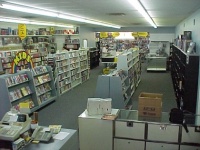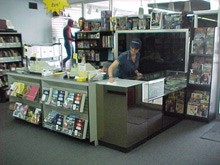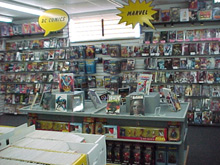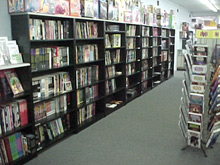
I mentioned in previous columns that Bookery Fantasy was undergoing a 'facelift,' with new carpet, fresh paint, rearranged displays, and a different layout. Though not exactly an 'extreme make-over,' the end result is a Bookery with a new look AND a new attitude toward comics retailing.
Inspired in part by the theories and observations of Paco Underhill, author of Why We Buy: The Science of Shopping (1999 Simon & Schuster), and looking toward future trends in the hobby industry, we set out to recreate Bookery Fantasy as a pleasing, friendly, spacious, and efficient retail environment. Though we had always prided ourselves on having a clean, well-lit, and organized store, to the casual observer (i.e., moms, wives, girlfriends, the guy who wanders in looking for maps, and the uptight customer looking for a 'real bookstore') it still looked like a stereotypical comic book shop in many ways. We wanted our first impression to non-comics customers to be more 'Wow!' than 'Woah!,' yet still emphasize comic books, which we've always considered our 'bread & butter.'
Our first step was to reduce the size of our counter area, cutting our counters from eight down to four, and moving it from a side wall (where it occupied nearly 40 feet of potential retail space) to the front of the store, creating new opportunities for displays, widening the floor space, and freeing up one long wall. In essence, we enlarged the store, simply by reducing and rearranging our employee area and checkout counters. Now, what to do with the free space?
Going back to the concept of comic books being our 'bread & butter,' we borrowed a product placement strategy from grocers. Think about the dairy section of most grocery stores: where is it located? In the very back of the store. So that's where we moved the comics. This serves two very important purposes: it forces our comic book customers to walk past all of our other product lines before they can browse the new releases and modern back issues (collectibles occupy a separate room), and takes the comic books out of the way for those consumers looking for pop culture goodies, such as manga, anime, DVDs, and paraphernalia from Buffy, Star Trek, and Star Wars. While comics are in no way hidden from view, and signage is clearly visible from nearly everywhere in the room, comic books no longer overwhelm the uninitiated the moment they walk in.
What does hit you like a ton of bricks are the racks and racks of graphic novels and trade paperbacks. That long wall we freed up is filled with 30 feet of book shelves, stocked with the best the industry has to offer, including a substantial number of small press alternative titles. On the opposite wall, racks of manga titles share space with imported Japanese plush and action figures, books low for easier browsing, toys pegged on slatwall above. How to Draw Manga manuals are displayed side-by-side with similar reference books on American comics, along with drawing paper and other art supplies. Many newcomers to the hobby are fans of Japanese properties on Cartoon Network's 'Adult Swim,' and are more receptive to manga than traditional fare offered by comic shops and mainstream bookstores. For pure anime-philes, across the aisle are freestanding racks of new and previously viewed anime DVDs and import CDs.
DVDs are displayed prominently center stage, offering the customer who reads less often some delicious Hollywood 'eye candy' as well as off-beat selections from Mario Bava, Jess Franco, Hammer Films, Ed Wood, and others. Like putting comics to the back of the store, placing DVDs directly in the center of the room offers multiple benefits, from more visible displays promoting impulse shopping, to better security and theft-reduction.
Racks, bookshelves, and back issue tables are all oriented to emphasize the length of the store, creating a greater impression of size in an already large area. The room looks and feels huge, deep. That sense of space was an important consideration in our design phase. In Why We Buy, Underhill writes '(t)he amount of time spent by shoppers in a given area is directly proportional to the amount of uninterrupted space (either actual or perceived) surrounding him or her ... if a section of a store feels roomy ... you'll feel inclined to linger.' So many comic book, gaming, and hobby stores feel compelled to cram as much into whatever space they have to maximize sales. By widening our aisles and keeping the rack count low, we may have reduced potential display space, but we gained invaluable psychological space.
Of course, theories don't always stand up to testing, and it's a little soon to declare Bookery's makeover a rousing success or miserable failure. Look over the pictures and decide for yourself, but if initial customer reaction and sales are any indication, we did good.





